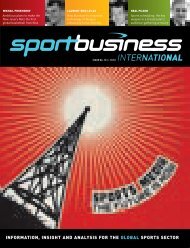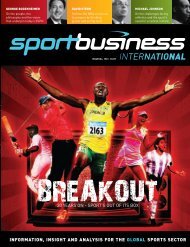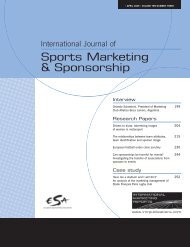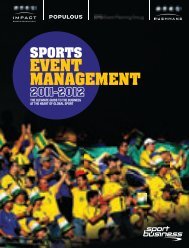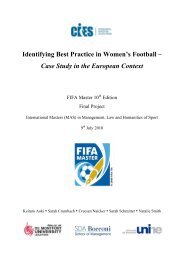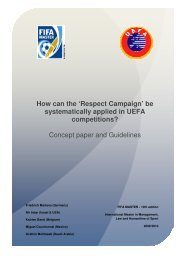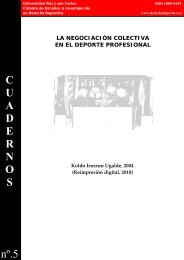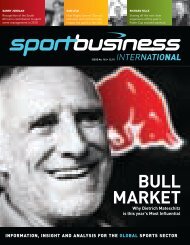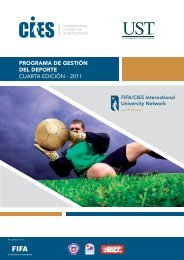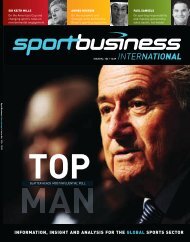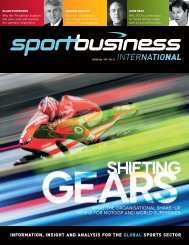Sports Marketing & Sponsorship - FIFA/CIES International University ...
Sports Marketing & Sponsorship - FIFA/CIES International University ...
Sports Marketing & Sponsorship - FIFA/CIES International University ...
- No tags were found...
You also want an ePaper? Increase the reach of your titles
YUMPU automatically turns print PDFs into web optimized ePapers that Google loves.
The value of competitionRESEARCH PAPERsuperior financial rewards through higher attendanceand higher revenue from the sale of broadcast,sponsorship and licensing rights (Hunt, 2000).Factors affecting fan demand<strong>Sports</strong> marketing literature has traditionally studiedfactors that affect fan demand from the consumerperspective. Laverie and Arnett (2000) and Arnett andLaverie (2000) use consumer behaviour theories toexamine attendance as a function of fan identity. Finket al (2002) research the role of fan and team gendersto explain attendance. Robinson and DeSchriver(2003) look at the demographic differences betweenthe fans of two teams competing in the NationalProfessional Soccer League. DeSchriver (1999) andWells et al (2000) research consumer factors thatinfluence fan attendance for one season and twosingle seasons respectively of American football,among schools that compete in the National CollegiateAthletic Association (NCAA) Division II. Noll (1974)and Baade and Tiehen (1990) include race as apredictor variable. Meir (2000) examines fan reactionto the league management’s marketing strategies.Based on a survey of team general managers andusing principal component analysis, Hansen andGauthier (1989) identify 10 factors that affect eithergame or season attendance. Kim et al (2007) andZhang et al (2003) follow a similar approach, askingresidents about factors that determine their attendanceat sporting events.Although these studies focus on importantcharacteristics of consumers of sporting events thatmay affect attendance, with the exception of Hansenand Gauthier, and Meir, there has been little researchon the factors that a team’s management, or itsleague’s management, could control in order to affectattendance. O’Reilly and Nadeau (2006) investigateleague expansion as a predictor of team revenue, butno study has been identified that includes changes inleague membership as a predictor variable ofattendance. Because much of the sports marketingliterature has focused on the consumer, thisperspective has shaped theoretical discussions. Thispaper looks at how the league can strategicallyimprove the entertainment value of its competitionsto consumers in order to increase attendance andrevenues.Outcome doubtPast research has demonstrated that uncertainty aboutthe outcome of a game is a component of predictiveattendance models. Borland and Lye (1992) and Peeland Thomas (1988, 1992, 1996) look at attendanceat a particular match as a function of outcomeuncertainty. Borland (1987) reviews the long-termeffect on attendance of a dominant team. Baimbridge(1997) and Hynds and Smith (1994) examine therole of doubt in an international athletics tournament.Noll (1974) and Baade and Tiehen (1990) attempt toinclude doubt by using several indicators, includingthe concentration of championships and the end-ofseasongap between the division winner and otherteams in that division. In each of these studies, doubtor match uncertainty is statistically significant inexplaining attendance. Zhang et al (2003) develop afactor to measure fans’ perceived attractiveness of amatch. Whitney (1988) shifted the research focusfrom match attendance to league attendance byinvestigating league championship uncertainty. Heargues that a league with a dominating team, or aleague with a non-competitive team, would experiencea decline in league attendance. Following this work,we use the league as the unit of analysis because it ismost appropriate to the study of the aggregate,strategic impact of competitive balance.AttendanceAttendance is treated in various ways in the literature.Wells et al (2000), Peel and Thomas (1996), Baadeand Tiehen (1990), Greenstein and Marcum (1981)and Noll (1974) use total league attendance whileothers employ match attendance (Baimbridge, 1997;Borland and Lye, 1992; Dobson et al, 2001; Knowleset al, 1992; Paul, 2003; Peel & Thomas, 1992;Jones & Ferguson, 1988; Welki & Zlatoper, 1994).Hansen and Gauthier (1989) use both game and12 <strong>International</strong> Journal of <strong>Sports</strong> <strong>Marketing</strong> & <strong>Sponsorship</strong> ● OCTOBER 2009 ●



